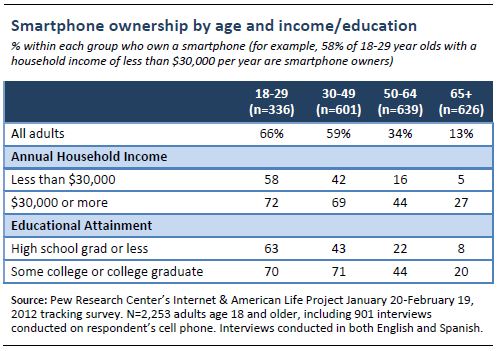46% of American adults now own a smartphone of some kind, up from 35% in May 2011; Smartphone owners now outnumber users of more basic phones
Nearly half (46%) of American adults are smartphone owners as of February 2012, an increase of 11 percentage points over the 35% of Americans who owned a smartphone last May. As in 2011, our definition of a smartphone owner includes anyone who said yes to either of the following two questions:
- 45% of cell owners say that their phone is a smartphone, up from 33% in May 2011
- 49% of cell owners say that their phone operates on a smartphone platform common to the US market,1 up from 39% in May 2011
Taken together, just over half of cell owners (53%) said yes to one or both of these questions and are classified as smartphone owners. Since 88% of US adults are now cell phone owners, that means that a total of 46% of all American adults are smartphone users. Two in five adults (41%) own a cell phone that is not a smartphone, meaning that smartphone owners are now more prevalent within the overall population than owners of more basic mobile phones.

As smartphone ownership has grown over the last year, there has been a corresponding shift in the specific types of phones that Americans report owning:
- 20% of cell owners now describe their phone as an Android device, up from 15% in May 2011
- 19% of cell owners now describe their phone as an iPhone, up from 10% in May 2011
- 6% of cell owners now describe the phone as a Blackberry, down from 10% in May 2011
The proportion of cell owners describing their phone as a Windows (2%) or Palm (1%) device is unchanged since the last time we asked this question in May 2011.
Smartphone ownership has increased across a wide range of demographic groups
Nearly every major demographic group—men and women, younger and middle-aged adults, urban and rural residents, the wealthy and the less well-off—experienced a notable uptick in smartphone penetration over the last year, and overall adoption levels are at 60% or more within several cohorts, such as college graduates, 18-35 year olds and those with an annual household income of $75,000 or more.
Although this overall increase in smartphone ownership is relatively wide-spread, several groups saw modest or non-existent growth in the last year. Chief among these are seniors, as just 13% of those ages 65 and older now own a smartphone. This is far below the national average of 46%, and is largely unchanged from the 11% of seniors who were classified as smartphone owners in 2011. Similarly, smartphone adoption among those without a high school diploma grew by a relatively modest seven percentage points over the last year, and overall adoption rates for this group continue to be roughly half of the national average (25% of those without a high school diploma currently are smartphone owners).
African-Americans and Latinos also exhibited modest changes in smartphone adoption between our 2011 and 2012 surveys. However, in contrast to those groups, both African-Americans and Latinos have overall adoption rates that are comparable to the national average for all Americans (smartphone penetration is 49% in each case, just higher than the national average of 46%).

As we found in our previous study of smartphone adoption, young adults tend to have higher-than-average levels of smartphone ownership regardless of income or educational attainment, while for older adults smartphone ownership tends to be relatively uncommon across the board—but especially so for less educated and affluent seniors. Among 18-29 year olds there is a 14-point difference in smartphone ownership rates between those earning less than $30,000 per year and those earning more than $30,000 per year (and smartphone ownership even among lower-income young adults is well above the national average). By contract, for those 65 and older, there is a 22-point difference between these income cohorts (and just 5% of low-income seniors are smartphone users).
Similarly, smartphone ownership decreases dramatically with age even among adults with similar levels of education. However, younger adults with a high school diploma or less are significantly more likely to own a smartphone than even those seniors who have attended college.

Confusion over the term “smartphone” has declined in the last year
As smartphone ownership has become more widespread over the last year, consumers have generally found it easier to answer questions about their phones and whether they own a smartphone or not. To be sure, there is still some confusion around this term as 8% of cell owners are still not sure if their phone is a smartphone. However, this is a significant decrease from the 14% of cell owners who were not sure if their phone was a smartphone or not in May 2011. Similarly, the proportion of cell owners who volunteered that they don’t know what type of phone they have fell from 13% of cell owners in May 2011 to just 4% of cell owners in February 2012.


